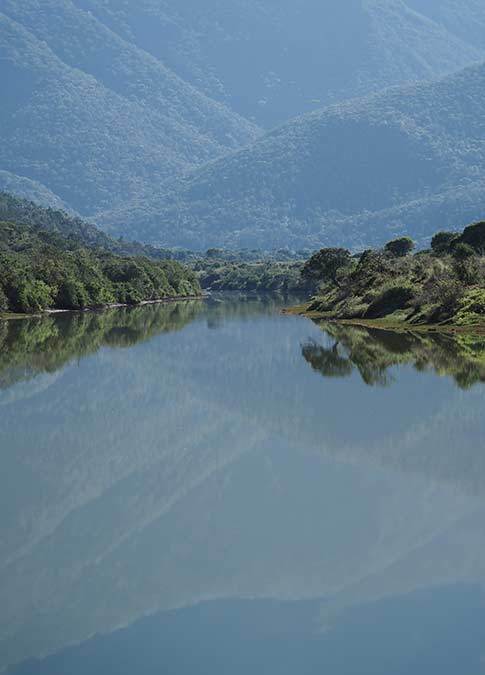Umkhosi: Top 10 Baby White Rhino Questions
On 21 October 2020 we welcomed a new baby white rhino to Kariega Game Reserve in South Africa. His birth was particularly exciting (we do get excited about the birth of every baby rhino!) as he is the first grandchild of the world's first poaching survivor.
Perhaps you have a few questions about why his birth is so special? Well, here is some background:
- On 2 May 2012 three white rhinos were poached at Kariega Game Reserve. Poaching is an illegal act of attacking a rhinoceros and removing its horns to be used in Chinese medicine. The rhino usually dies. Rhino horn has no proven medicinal benefits.
- Prior to this date, no rhinos had survived poaching attacks. In 2012 at total of 751 rhinos died in South Africa, that is more than two rhinos per day.
- We named the first rhino poaching survivor Thandi, meaning courage in our local Xhosa language. The other two rhinos did not survive.
- Thandi endured many surgeries to try to help heal the huge wound on her face. She was also the first rhino to have a skin graft!
- To our delight, Thandi gave birth to a female calf on 13 January 2015. We called the calf Thembi, meaning hope in Xhosa.
- During 2015, rhino poaching resulted in the death of an alarming 1,349 rhino in South Africa. This means four rhinos were killed every day and the species was becoming vulnerable to extinction. Due to activities of conservationists and supporters from around the world, the annual rhino poaching numbers is now declining but rhinos remain at risk and every new rhino counts.
- This is why the arrival of Thembi’s calf, a third generation of Thandi’s family, is so important. We need to ensure that rhinos can safely live in and thrive in our remaining wild places.
The new baby white rhino is called Umkhosi, meaning army in Xhosa. This name honours the conservation army that helped his grandmother Thandi survive after being poached, supports us to protect his mum Thembi, the rhino crash at Kariega and other rhinos around the world.

Umkhosi: Top 10 Baby White Rhino Questions and Answers
Ok, so now that we have covered the background we can get on to answer the top 10 baby white rhino questions. We hope that you enjoy the video of the one-month-old baby white rhino Umkhosi and his mum Thembi in the wilderness at Kariega Private Game Reserve. This video was taken by our resident wildlife film maker Fergus Clark.
1. What do baby white rhinos look like at birth?
Mum Thembi was pregnant for around 16 months before giving birth to Umkhosi. Southern white rhinos most often give birth to a single calf which usually weighs between 40 and 65 kg (88 and 143 lb). Rhino calves can stand and walk very quickly after birth but they are unsteady on their large feet for their first two to three days of life. We love that you can see how big Umkhosi's feet are in the video.
The skin of a white rhino is grey, unlike what you may expect from its name! An alternative name for a white rhinoceros is a square-lipped rhinoceros. A baby rhinos skin is very wrinkled when it is born. It has big and flexible ears and a bump where the two horns will grow.
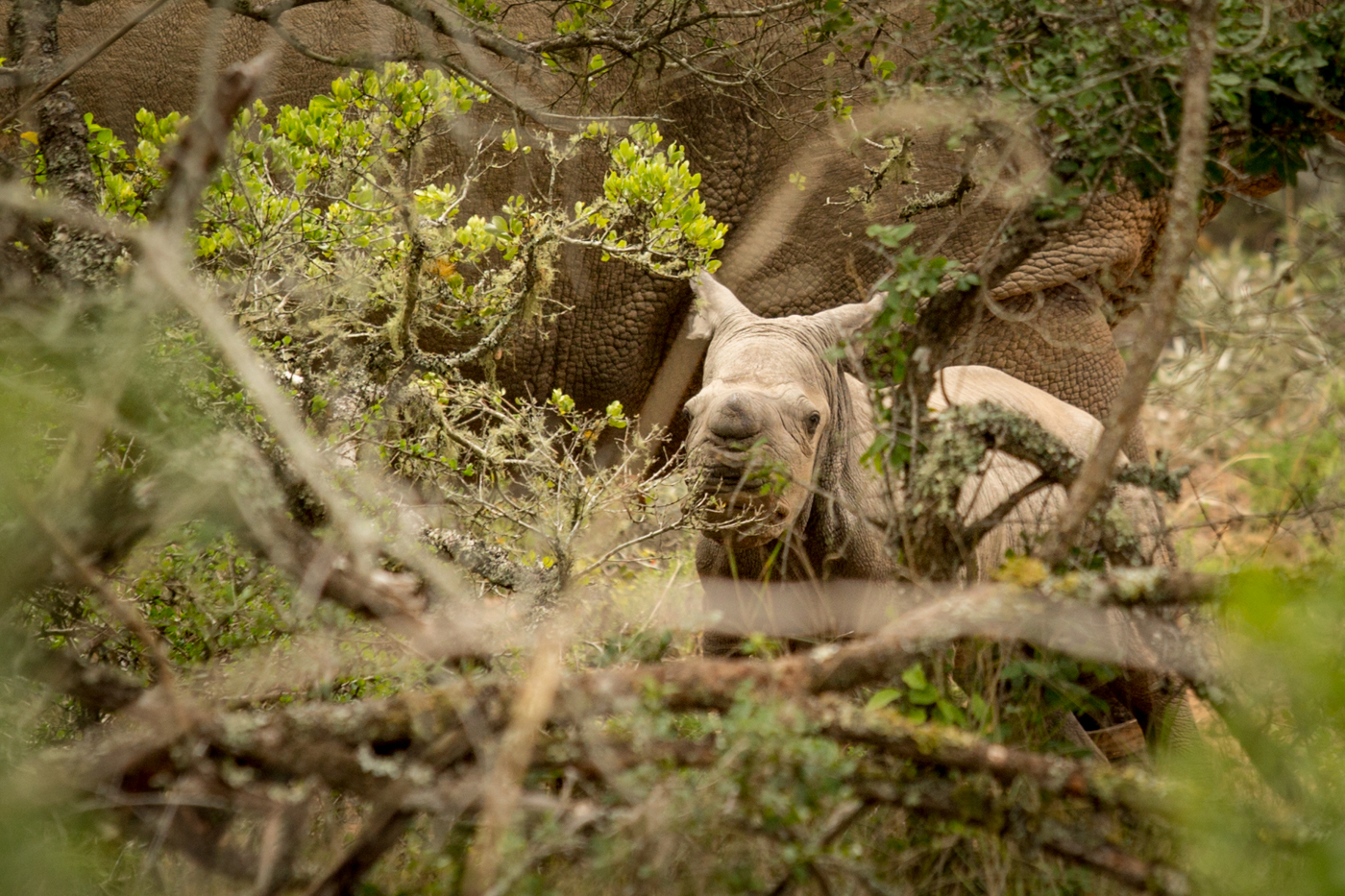
2. What do baby white rhinos sound like?
Although you can't hear the sounds in this video baby rhinos can be quite noisy, especially when they want a drink of milk! Babies make a variety of squeals, grunts and snorts. Adult rhinos also produce lots of different sounds, including bellows, growls and of course lots of munching when eating.
Click on this link to watch a cute video of Thembi making lots of squealing noises when she was a baby rhino.
3. What do white rhino calves eat and drink?
White rhinos are mammals and so babies drink milk from their mothers. Umkhosi will only drink milk for the first two months of his life. He then will start to eat grass but continue to suckle until he is a year old.
Baby rhinos eat their mums poo! This may sound awful but this is for a good reason. Find out why in our video: Why baby rhinos eat poo?
All rhinos are herbivores and eat grass and plants. Despite their huge size and strength they don’t prey on other animals for food. White rhinos eat grass and black rhinos eat mostly leaves. If you look at the lips and mouth of a rhino it will help you to identify the species. White rhinos have square mouth which acts a bit like a lawnmower to help them much on lots of grass. The top lip of a black rhino is pointed which helps it to pluck leaves and fruit from branches.
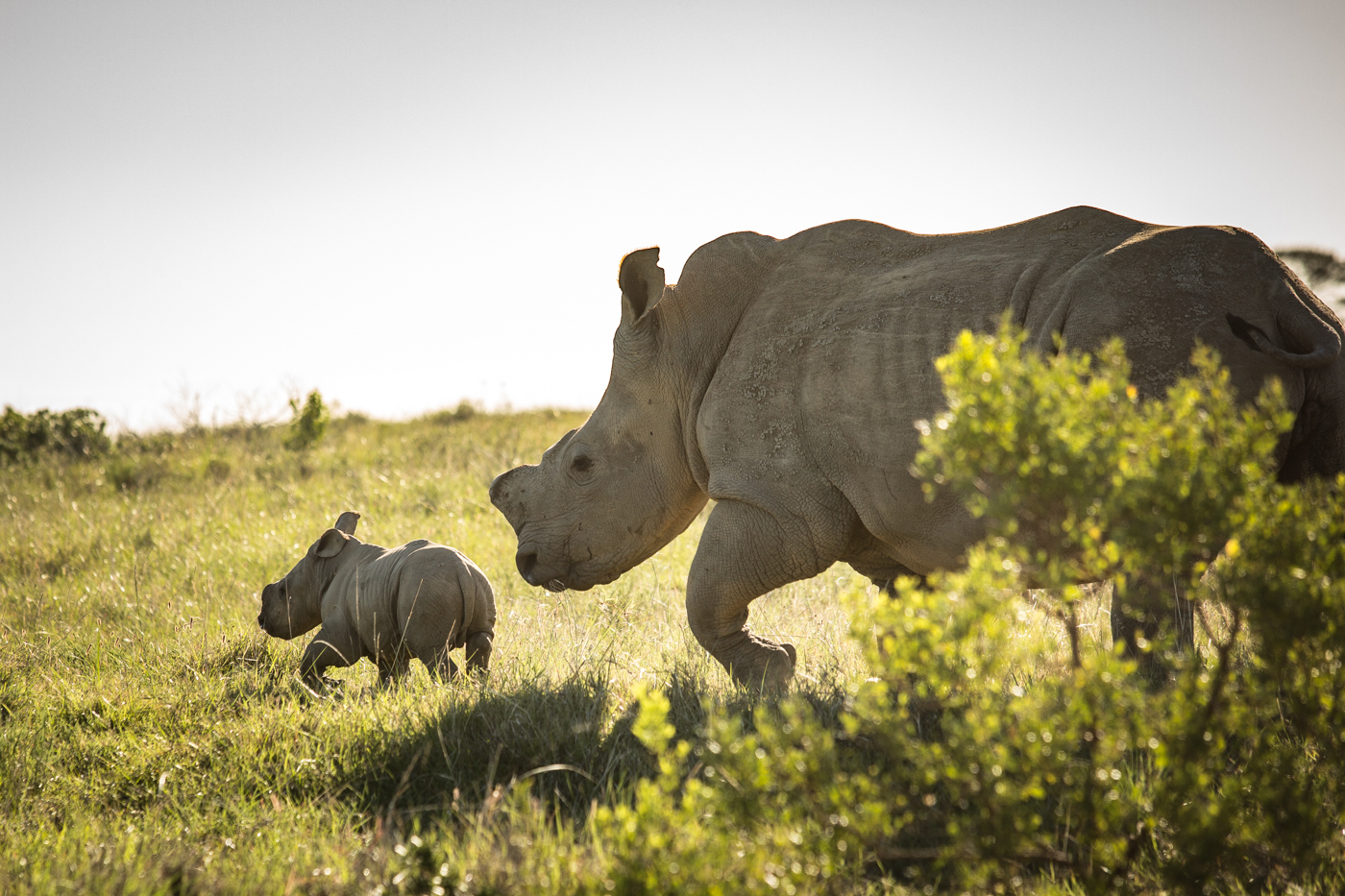
4. What do little rhinos like to do?
As you can see in the video, Umkhosi is full of energy and likes to walk, run, stamp his legs, sniff, roll in the grass, move his ears and lie down. He needs to take lots of naps! He stays very close to his mum for protection and milk.
You may have noticed tin the picture above and in the video that Umkhosi mostly walks in front on his mother. The reason for this is thought to be so that the mother can keep her eyes on her calf incase of any predators. When in flight, black rhino calves are most often seen behind their mothers. We think the reason is because black rhinos live in bushy areas and the mum runs ahead of the calf to make it easier and faster for them to get through the vegetation.
White rhinoceroses are social animals and live in groups called crashes. These groups mostly include females and their offspring. Thembi will most likely introduce her new baby to other female rhinos in the next few weeks. She is likely to spend time with Thandi, the grandmother of Umkhosi and Thembi's mother.
5. Do baby rhinos sleep?
Yes! Baby rhinos need to take regular naps. They usually sleep in stages at different times of the day. Even adult rhinos need to sleep for about 8 or 9 hours each day.
White rhinos sleep lying down, rather than standing, and often sleep in the shade of a tree. When they have a deep sleep, they lie down with their feet curled up slightly to the one side. You'll see Umkhosi in this position towards the end of the video.
Click on this link to watch a video of a baby rhino having a nap when he is just two months old.
6. How big do male white rhinos get?
White rhinos are the second largest land mammal, after the African elephant. White rhinos (Ceratotherium simum) are the largest species of rhinoceros and male white rhinos can grow to 1.8 m (5.9 ft) tall and weigh up to 2,500 kg (5,500 lbs) – that’s the weight of 30 men!
Little Umkhosi has a long way to go but we intend to keep him protected to ensure that he can reach this size and live a healthy and long rhino life!
7. Where do southern white rhinos live?
The southern white rhino lives in southern Africa. The vast majority occur in just four countries: South Africa, Namibia, Zimbabwe and Kenya. White rhinos can mostly be found on the plains as they are grazers and eat grass.
Kariega safari guests are fortunate to enjoy regular close-up sightings of white rhinos and numerous other wildlife, birds, insects and reptiles while out on twice daily game drives with their experienced driver and guide. The safari vehicles have no roof, the seats are set up high and the vehicle does not have windows or doors. The guides are trained and experienced to ensure safe and comfortable wildlife viewing.
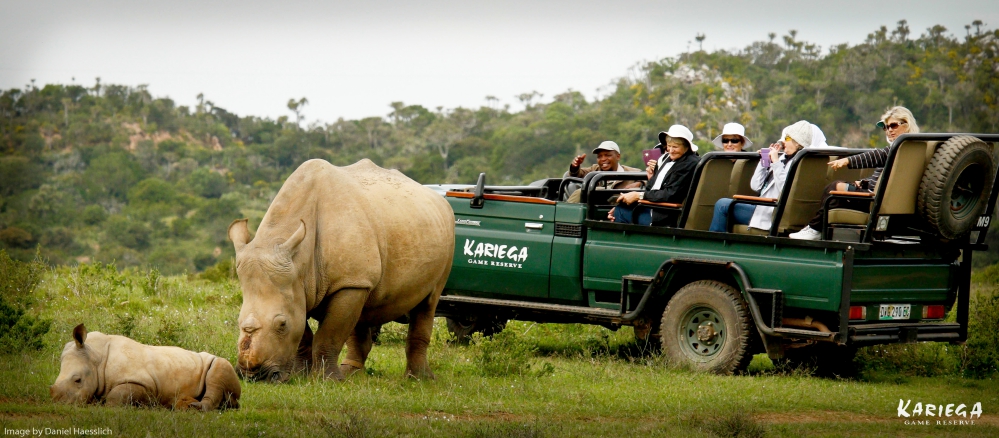
How many southern white rhinos are left in the wild?
There are five species of rhino - only the white and black rhino live in Africa while the other three live in Asia.
There are estimated to be just over 20,000 southern white rhino living in the wild, yet only in protected areas and private game reserves such as Kariega. There are only two remaining northern white rhino remaining, both are females living in Kenya.
According to the latest update in March 2020, the International Union for Conservation of Nature (IUCN) listed the wild black rhino population as a mere 5,630 animals. The species is critically endangered and at extremely high risk of extinction in the wild.
How can I help protect rhinos and other wildlife?
Due to threats from poachers we operate a full-time anti-poaching unit (APU) to keep Umkhosi, his family and the rest of the rhino at Kariega protected.
The travel bans due to Covid-19 have cut key sources of our conservation funds, including those generated from guest conservation levies. In order to keep our APU active and protecting endangered rhino we are appealing for funds.
You can make a donation to the Kariega Foundation Save the Rhino fund via credit card via our online donation system or by EFT into the Kariega Foundation bank account.
First National Bank (or FirstRand Bank)
Account no: 62275606526
Branch: Newton Park
Branch code: 261050
Swift/IBAN: FIRNZAJJ or FIRNZAJJXXX
Bank Head Office Address: FNB Bank City, Simmonds Street, Johannesburg, 2000
Every donation to our Kariega Foundation rhino conservation projects is appreciated and will be used to protect, preserve and conserve rhino at Kariega Game Reserve in South Africa's Eastern Cape. Please email us on foundation@kariega.co.za to find out more or to ask questions.
The Kariega Foundation is a non-profit trust that working in collaboration with Kariega Game Reserve on conservation and community projects. We so appreciate your support.
Can I see a baby rhino in the wild at Kariega Game Reserve?
If you visit in the next few months you will be able to ask your safari guide to try to locate baby rhino Umkhosi and his mum Thandi. If you are successful, please tag us in your pictures and videos on Instagram and Facebook.
If you will be visiting at a later stage you are still likely to enjoy sightings of baby animals, including rhino, in our wilderness area. However, as all the animals are wild we cannot guarantee that there will be a baby rhino when you visit!
Kariega Game Reserve offers safari guests the opportunity to see wildlife during twice daily game drives, guided bush walks and river trips. All activities are lead by a passionate, qualified and experienced guides. The safari experience includes accommodation in five separate lodges, all meals and beverages (except beverages are paid separately at Main Lodge). Contact our reservations team if you would like to find out more.
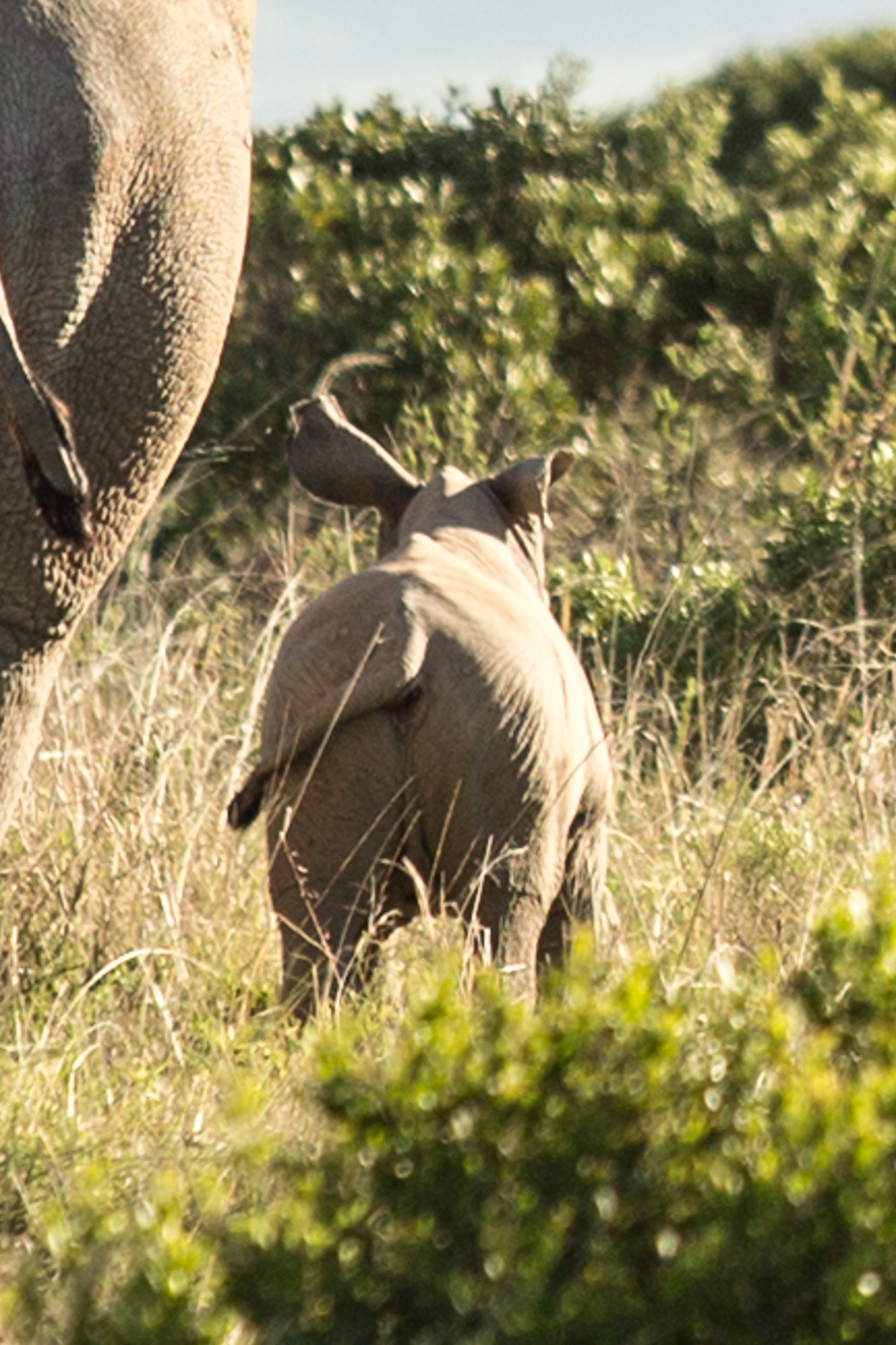
Images thanks to APU leader Daniel Haesslich and Kariega Foundation coordinator Jone Haesslich.

